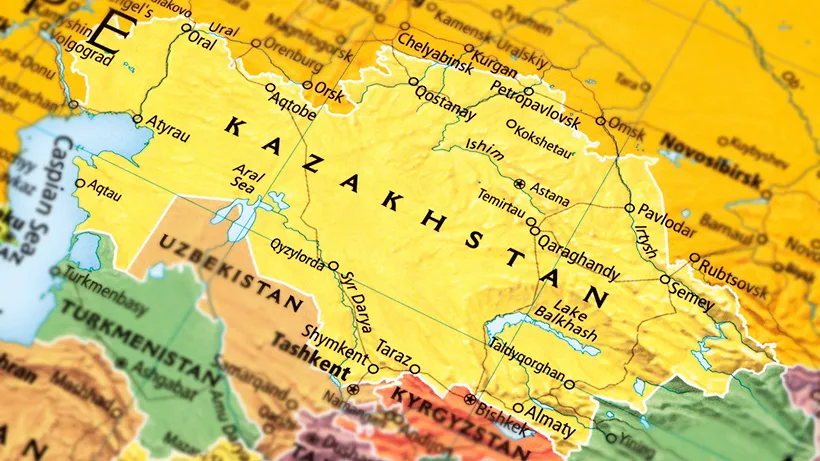The Silk Road is a good reason to take a look at Kazakhstan

Next year Kazakhstan will also host the Specialised Expo 2017. Protection of sales receivables is important.
Finland may have a long land border with Russia, but it cannot rival with Kazakhstan in Central Asia.
The border shared by Kazakhstan and Russia is no less than 6,500 kilometres long, and the border with China is measures 1,500 kilometres. The former Soviet republic is the world’s largest landlocked country, whose most famous ‘resident’ is probably the bumbling TV reporter Borat created by comedian Sacha Baron Cohen.
Yet laughs end abruptly when the Silk Road is mentioned. Under China’s leadership, the ancient trade route is seeing a new prosperity, and Kazakhstan has a central location as a transit country.
China has invested much prestige and tens of billions of euros to give new life to the Silk Road. An indication of the massive scale of the project, known as ‘One Belt, One Road’, is the fact that the Silk Road connects 64 countries covering an area that is home to 4.4 billion people.
The aim is to create frequent train and airline connections as well as a road network between Europe and Asia.
“China acts as the engine. Since the projects are really big, it may prove difficult for Finnish companies to get a foot in the door. Working as a subcontractor might be a more suitable role,” says Outi Homanen, Senior Adviser at Finnvera.
Foreign companies are needed at least when planning and implementing infrastructure, transport, logistics, and information and communications technology.
Homanen continues the list for Kazakhstan.
“Kazakhstan has identified sustainable development as its goal, and the government supports renewable energy projects, for example. In addition, know-how in cleantech, education and mining attracts interest,” she explains.
Next year in the spotlight
In other respects, too, Finnish companies should take a closer look at Kazakhstan. The reason is the Specialised Expo 2017 to be held next year in Astana.
Finland will have its own pavilion at the event. More information on this topic is available here.
“Participation in the Expo will entail much positive visibility and new opportunities for Finland, especially in the cleantech sector,” Homanen believes.
Despite the Expo and the opportunities brought by the Silk Road, Finnvera classifies Kazakhstan as a high-risk country.
The decline in oil prices has almost halved export revenue and inflation is soaring at over ten per cent. The value of the currency collapsed last year but is now more stable. The difficult financial situation has also accentuated the role of State-owned companies.
Partly for these reasons, Finnish companies are not a familiar sight in Kazakhstan.
“The business environment is challenging. It may therefore be difficult to predict how companies will behave. In general, timetables stretch. On the other hand, cash may be found if there is an urgency. It is highly important to protect receivables, and we recommend that letters of credit be used,” says Homanen describing the situation.
A letter of credit is a written undertaking given by the buyer’s bank for the payment of the purchase price to the seller.
Homanen also mentions the political situation as an additional question mark. Kazakhstan has only had one president, Nursultan Nazarbayev.
“It’s very uncertain what will happen after him. One must be prepared for major changes,” Homanen muses.
FACT: Kazakhstan in figures
Finnvera’s country risk category for Kazakhstan is 6/7. Kazakhstan is an important exporter of oil and gas. The country is also rich in other natural resources. The country’s indebtedness has increased in step with the collapse of oil prices, which weakens the income flow.
Kazakhstan’s political situation is currently relatively stable. Finnvera’s country exposure is about EUR 10 million. When assessing country risk categories, Finnvera cooperates with the OECD group of country risk experts.
Kazakhstan is currently a member of the World Trade Organization (WTO).
Gross domestic product: EUR 110 billion (2015). In 2014, the GDP was EUR 185 billion. Finland’s gross domestic product is EUR 207 billion (2015).
Gross domestic product per capita: EUR 6,230 (2015). In 2014, the gross domestic product per capita was EUR 10,600. Finland’s gross domestic product per capita is EUR 37,827 (2015).
Economic growth: Forecast 0.1–0.7% (2016). The growth rate was 1% in 2015 and 4.3% in 2014.
Inflation: 13.6% (2015).
Exports: About USD 46 billion (2015).
Imports: About USD 30 billion (2015).
Principal sectors: Oil and gas industry, ore and metal industry. Kazakhstan is a Top 20 oil producer country. Oil production averages around 1.5–1.6 million barrels per day, or roughly the same as Norway. The world’s average oil production is 80 million barrels per day.
Currency, the Tenge: The exchange rate is 1 euro to 376 tenges.
Finnish citizens can travel to Kazakhstan without a visa when they stay for a maximum of 15 days. The visa waiver is limited in time and expires at the end of next year.
More information about Finnvera’s export credit guarantees is available here.
Sources: Statistics Finland, World Bank, IMF, Asian Dev Bank, Focus Economics.
Text: Kimmo Koivikko
